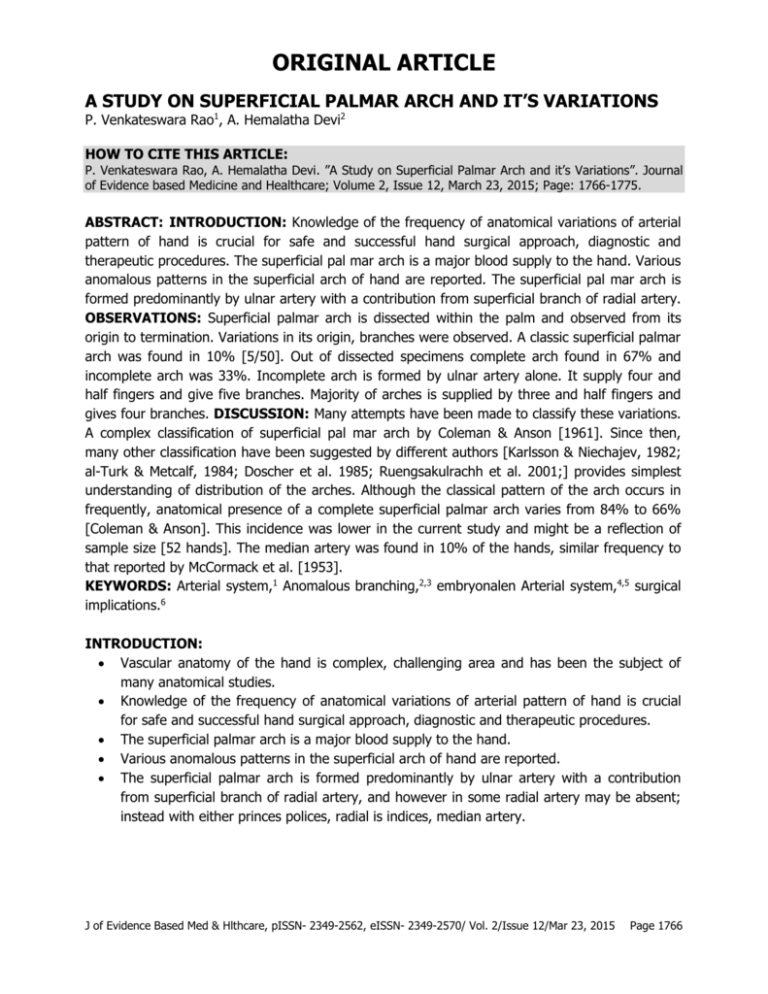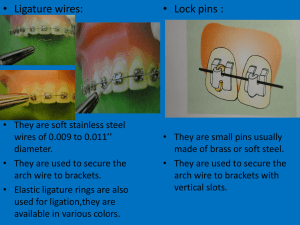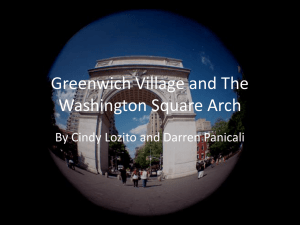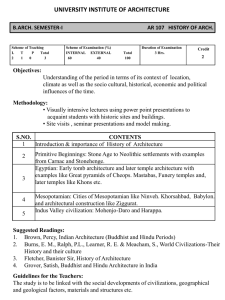a study on superficial palmar arch and it`s variations
advertisement

ORIGINAL ARTICLE A STUDY ON SUPERFICIAL PALMAR ARCH AND IT’S VARIATIONS P. Venkateswara Rao1, A. Hemalatha Devi2 HOW TO CITE THIS ARTICLE: P. Venkateswara Rao, A. Hemalatha Devi. ”A Study on Superficial Palmar Arch and it’s Variations”. Journal of Evidence based Medicine and Healthcare; Volume 2, Issue 12, March 23, 2015; Page: 1766-1775. ABSTRACT: INTRODUCTION: Knowledge of the frequency of anatomical variations of arterial pattern of hand is crucial for safe and successful hand surgical approach, diagnostic and therapeutic procedures. The superficial pal mar arch is a major blood supply to the hand. Various anomalous patterns in the superficial arch of hand are reported. The superficial pal mar arch is formed predominantly by ulnar artery with a contribution from superficial branch of radial artery. OBSERVATIONS: Superficial palmar arch is dissected within the palm and observed from its origin to termination. Variations in its origin, branches were observed. A classic superficial palmar arch was found in 10% [5/50]. Out of dissected specimens complete arch found in 67% and incomplete arch was 33%. Incomplete arch is formed by ulnar artery alone. It supply four and half fingers and give five branches. Majority of arches is supplied by three and half fingers and gives four branches. DISCUSSION: Many attempts have been made to classify these variations. A complex classification of superficial pal mar arch by Coleman & Anson [1961]. Since then, many other classification have been suggested by different authors [Karlsson & Niechajev, 1982; al-Turk & Metcalf, 1984; Doscher et al. 1985; Ruengsakulrachh et al. 2001;] provides simplest understanding of distribution of the arches. Although the classical pattern of the arch occurs in frequently, anatomical presence of a complete superficial palmar arch varies from 84% to 66% [Coleman & Anson]. This incidence was lower in the current study and might be a reflection of sample size [52 hands]. The median artery was found in 10% of the hands, similar frequency to that reported by McCormack et al. [1953]. KEYWORDS: Arterial system,1 Anomalous branching,2,3 embryonalen Arterial system,4,5 surgical implications.6 INTRODUCTION: Vascular anatomy of the hand is complex, challenging area and has been the subject of many anatomical studies. Knowledge of the frequency of anatomical variations of arterial pattern of hand is crucial for safe and successful hand surgical approach, diagnostic and therapeutic procedures. The superficial palmar arch is a major blood supply to the hand. Various anomalous patterns in the superficial arch of hand are reported. The superficial palmar arch is formed predominantly by ulnar artery with a contribution from superficial branch of radial artery, and however in some radial artery may be absent; instead with either princes polices, radial is indices, median artery. J of Evidence Based Med & Hlthcare, pISSN- 2349-2562, eISSN- 2349-2570/ Vol. 2/Issue 12/Mar 23, 2015 Page 1766 ORIGINAL ARTICLE CLASSIFICATION OF COLEMAN AND ANSON (1961)(7): It is classified into two groups. GROUP 1: Complete arch (78.5%) is further divided into five types. TYPE A: The classical radio ulnar arch formed by superficial palmar branch of radial artery and ulnar artery [34.5%]. TYPE B: This arch is entirely by ulnar artery [37%] TYPE C: Medio-ulnar arch [3.8%] TYPE D: Radio- mediano ulnar arch [1.2%] TYPE E: This arch initiated by ulnar artery and completed by a vessel from Deep arch [2%] GROUP 2: Incomplete arch- when the contributing arteries from ulnar artery Fails to form an arch; it is incomplete. It can be further divided into 4 types: TYPE A: both superficial palmar branches of radial and ulnar artery take part in supply but fail to anastomose [32%]. TYPE B: only the ulnar artery forms the arch but is incomplete in sense that it does not supply thumb and index [13.4%]. TYPE C: superficial vessels receive contribution from the both median and ulnar arteries but without anastomosis [3.8%]. TYPE D: radial, median and ulnar arteries all give origin to superficial vessels but don’t anastomose [1.1%]. The above classification was considered for present study; SCOPE & OBJECTIVES: The objective of present study was to evaluate these arterial variations,(8) with special attention to the superficial palmar arch contributing vessels and its major branches. The purpose of study was to add new information on the variations of these vessels with respect to the presence or absence of a complete superficial palmar arch and to correlate the findings with laterality information. Variations in the ulnar artery branches which supply the fingers are utmost important in ischemia. Harvesting radial arteries for use as arterial bypass conduits, one of the risks associated with hand collateral circulation. This study has been taken up because superficial palmar arch and its variation including the collateral circulation are having a lot of surgical importance and it is of major help to the vascular surgeons. J of Evidence Based Med & Hlthcare, pISSN- 2349-2562, eISSN- 2349-2570/ Vol. 2/Issue 12/Mar 23, 2015 Page 1767 ORIGINAL ARTICLE Through the study was mainly confined to morphology of formation of superficial palmar arch and its variations an attempt is made in this direction to study the arch from its information to its termination. The study has been taken carefully so that the data collected by an anatomist can render to the progress of art and science of surgery is to discuss the difficulties to which surgeons are exposed. MATERIAL & METHODS: 52 hands from 26 embalmed human cadavers were studied. Variations of palmar arches were recorded. This study was carried out during routine dissections sessions for medical students in Siddhartha medical college, Vijaywada. Among 52 hands 12 hands dissection study carried out at NRI medical college, chinnakakani, Guntur. The cadavers were formalin fixed; skin was carefully dissected to avoid overlooking any contribution of superficial vessels to the palmar arch. All arteries and nerves distal to the elbow joint were identified and dissected on either side of limbs. Anomalous tortuosities, dilatations, aneurysms or occlusive disease tissue were discarded at the beginning of the study. An anatomically normal superficial palmar arch was defined and noted with certain variations. The dissected palms with vessels insitu were serially tagged using plastic tokens with numbers on either side of upper limbs and preserved in formaldehyde solution. OBSERVATION: Superficial palmar arch is dissected within the palm and observed from its origin to termination. Variations in its origin, branches were observed. A classic superficial palmar arch was found in 10% [5/50]. Out of dissected specimens complete arch found in 67% and incomplete arch was 33%. Type of Arch Complete Complete Incomplete Arteries Forming arches Radial & ulnar Ulnar & median Ulnar artery No. of Specimens 33 2 17 % 63 3.8 33 Table 1: Superficial palmar arch In completed arch formed by ulnar artery alone, which in majority of cases supplies 3½ fingers. J of Evidence Based Med & Hlthcare, pISSN- 2349-2562, eISSN- 2349-2570/ Vol. 2/Issue 12/Mar 23, 2015 Page 1768 ORIGINAL ARTICLE Graph 1 Incomplete arch is formed by ulnar artery alone. It supply four and half fingers and give five branches. Majority of arches is supplied by three and half fingers and gives four branches. No. of % Specimens Complete 35 67 Incomplete 17 33 Table 2: Superficial palmar arch Type of Arch The following shows the percentage of the total specimens. Graph 2 J of Evidence Based Med & Hlthcare, pISSN- 2349-2562, eISSN- 2349-2570/ Vol. 2/Issue 12/Mar 23, 2015 Page 1769 ORIGINAL ARTICLE Coleman & Anson Ikeda (9) Ruengsa kularch(10) Present study (7) Complete (%) 78.5 96.4 66 63 Incomplete (%) 21.5 3.6 34 33 TABLE 3: Superficial palmar arch Among the observations of specimens done complete arch formed by radial artery in some, ulnar artery and medial artery in few specimens. DISCUSSION: Superficial palmar arch and its branches supply the hand. The vascular patterns of the palmar arches(11) and their inter connecting branches present a complex and challenging area of study. Many attempts have been made to classify these variations. A complex classification of superficial pal mar arch by Coleman & Anson [1961].(7) Since then, many other classification have been suggested by different authors [Karlsson & niechajev, 1982; al(12,13) Turk & Metcalf,1984(14); Doscher et al.1985; Ruengsakulrachh et al. 2001;(10) provides simplest understanding of distribution of the arches. The variations observed in this study were congenital/developmental in origin. Although the classical pattern of the arch occurs in frequently, anatomical presence of a complete superficial palmar arch varies from 84% to 66% [Coleman & Anson].(7) This incidence was lower in the current study and might be a reflection of sample size [52 hands]. The median artery was found in 10% of the hands, similar frequency to that reported by McCormack et al.[1953].(15) Although o’ Sullivan & Mitchell [2002](16) suggested that absence of pal maries long us tendon was present in all cases examined here. Right superficial palmar arch, described in literature, showing all the branches in the current study. An incomplete superficial palmar arch(17) formed only by the ulnar artery in the above 1st specimen. A superficial palmar arch in which the median artery substituted the radial artery to complete the arch in the 2nd specimen. TABLE FOR DISCUSSIONS: Author Coleman & Anson Ikeda Ruengsa kularch Present study Complete 78.5 96.4 66 63 Incomplete 21.5 3.6 34 33 J of Evidence Based Med & Hlthcare, pISSN- 2349-2562, eISSN- 2349-2570/ Vol. 2/Issue 12/Mar 23, 2015 Page 1770 ORIGINAL ARTICLE Graph 4 Prevalence of persistent median artery: Sl. No 1. 2. 3. 4. 5. 6. 7. Author of the year Tandler et al (1887) Adachi (1928)(2) Misra (1955) Coleman & Anson (1961)(7) Keen (1961)(18) Anson (1966)(4) Karlsson (1982)(13) % age 16% 8% 8.4% 9.9% 9.5% 8.0% 4.0% Coleman and Anson (1961) classified the superficial palmar arch in 2 groups. GROUP 1: Complete arch (Found in 78.5% cases) is further divided into five types: TYPE A: The classical radio ulnar arch formed by superficial palmar branch of radial artery and the larger ulnar artery (34.5%). TYPE B: This arch is formed entirely by ulnar artery (37%). TYPE C: Media no – ulnar arch is composed of ulnar artery and an enlarged median artery (3.8%) (8% by Anson, 1966). TYPE D: Radio- mediano - ulnar arch in which 3 vessels enter into formation of the arch (1.2%). TYPE E: it consists of a well formed arch initiated by ulnar artery and completed by a large sized vessel derived from deep arch (2%). J of Evidence Based Med & Hlthcare, pISSN- 2349-2562, eISSN- 2349-2570/ Vol. 2/Issue 12/Mar 23, 2015 Page 1771 ORIGINAL ARTICLE GROUP II: TYPE A: Both superficial palmar branch of the radial artery and ulnar artery take part in supplying the palm and fingers but in doing so fail to anastomose (3.2). TYPE B: Only the ulnar artery forms the superficial palmar arch but arch is incomplete in the sense that it does not supply the thumb and the index finger (13.4%). TYPE C: Superficial vessels receive contribution from both median and ulnar arteries but without anastomosis (3.8%). TYPE D: Radial, median and ulnar arteries all give origin to superficial vessels but don’t anastomose (1.1%). SUMMARY & CONCLUSION: Variations in the termination of radial and ulnar arteries are common. Although the classic type of the superficial palmar arch occurs relatively infrequently, there is always a significant anastomosis between the radial and ulnar artery in hand. In the absence of vascular disease, harvesting the radial artery should be a safe procedure. The variations in the present study may have resulted from the median artery, identifying the median artery as one of the causes for carpel tunnel syndrome is crucial for proper management. In addition the palmar arterial network arrangements are intricate. In addition of any variation in the arterial pattern of hand using Doppler us, oximeteric techniques acquire great importance in various surgical interventions in the hand. The results of the present study have been discussed in detailed and comparative study has been discussed in detailed and comparative study has been made with available data. Further, in the present study, median artery shows forming superficial palmar arch 2% of cases. To conclude the findings of the present study may be useful for vascular surgeons at large. REFERENCES: 1. Keible, F. and mall, F.P: manual of human embryology. In: development of blood vascular system – the arteries. Vol. II, 1st Edn., J.B. Lippincott Co., Philadelphia and London: pp. 659-67.(1912). 2. Adachi: Das Arteries system1 des japaner, Kyoto, Vol 1, (1928). 3. Bhargava, 1. (1956! Anomalous branching2 of axillary artery. Journal of the anatomical society of India (5): pp.78-80. 4. Anson, B. J: Morris’ Human anatomy, In: CVS – arteries and veins; Mc Graw Hill Book Co., New York, Toronto: pp. 708-24(1966). 5. Boyd J. D., Clark, W.E., Hamilition, W.J; Yoffet, J.M; Zuckerman, S. & Appleton, A.B.: Textbook of human anatomy. In: CVS – Blood vessels. Macmillan &Co. Ltd., New York, London: pp.341-46. (1356). J of Evidence Based Med & Hlthcare, pISSN- 2349-2562, eISSN- 2349-2570/ Vol. 2/Issue 12/Mar 23, 2015 Page 1772 ORIGINAL ARTICLE 6. Arey: developmental anatomy. In: development of the arteries. 6th Ed. W.B. Saunders Co., Philadelphia: pp.375-77(1957). 7. Coleman, S, and Anson, J. (1961): arterial pattern in hand – based upon a study of 650 specimens. Surgery. Gynecology. Obstetrics, [113(4)]: pp. 409-24. 8. Goppert (1908): Variabilitat im embryonalen Arterien system3Verhandlungen der anat. Gesellschaft 22. versammlung erg-haft Z, anatomical anzeles S.94. 9. Ikeda A, Ugawa A, Kazihara Y, Hamada N (1988) arterial patterns in the hand based on a three-dimensional analysis of 220 cadaver hands. J Hand surg, 13A:501-509. 10. Ruengsakularch P, Eizenberg N, Fahrer C, Fahrer M, Buxton BF (2001) surgical implications4 of variations in hand collateral circulation: anatomy revisited. J. Thorac. Cardiovasc.surg.122, 682-686. 11. Gajisin S, Zbrodowski A (1993) Local Vascular contribution of the superficial palmar arch. Acta Anat. 147,248-251. 12. Karlsson, S. and Niechaiev CLQ82). Arterial anatomy of the upper extremity. Acta. Radiology. Diagnosis.,(23): pp. 115-21. 13. Karlson S, Niechajev IA (1982) Arterial anatomy of the upper extremity. Acta Radiol Diag, 2: 115-121. 14. Al-Turk M, Metcalf WK (1984) a study of the superficial palmar arteries using Te Doppler ultrasonic flow meter. J. Anat. 138, 27-32. 15. Mc Cormack LJ, Cauldwell EW, Anson BJ (1953) Branchial and antebranchial arterial patterns. A study of 750 extremities. Surg.Gynecol. Obstet. 96, 43-54. 16. Durgun B, Yucell AH, Kizilkanat ED, Dere F (2002) Multiple arterial variation of the human upper limb.Surg Radiol Anat, 24: 125-128. 17. Gellman, H, Botte MJ, Shankwiler J, Gelberman RH (2001) Areterial patterns of the deep and superficial palmar arches. Clin.orthop.Relat.R.383, 41-46. 18. Keen, J.A. (1981): a study of arterial variations in the limbs with special reference to symmetry of vascular patterns. American journal of anatomy, (108): pp.245-61. 1985. J of Evidence Based Med & Hlthcare, pISSN- 2349-2562, eISSN- 2349-2570/ Vol. 2/Issue 12/Mar 23, 2015 Page 1773 ORIGINAL ARTICLE J of Evidence Based Med & Hlthcare, pISSN- 2349-2562, eISSN- 2349-2570/ Vol. 2/Issue 12/Mar 23, 2015 Page 1774 ORIGINAL ARTICLE AUTHORS: 1. P. Venkateswara Rao 2. A. Hemalatha Devi PARTICULARS OF CONTRIBUTORS: 1. Assistant Professor, Department of Anatomy, Siddartha Medical College, Vijayawada. 2. Associate Professor, Department of Physiology, Siddartha Medical College, Vijayawada. NAME ADDRESS EMAIL ID OF THE CORRESPONDING AUTHOR: Dr. P. Venkateswara Rao, Katuri Medical College, Guntur. E-mail: vrpotv@gmail.com Date Date Date Date of of of of Submission: 05/03/2015. Peer Review: 06/03/2015. Acceptance: 13/03/2015. Publishing: 18/03/2015. J of Evidence Based Med & Hlthcare, pISSN- 2349-2562, eISSN- 2349-2570/ Vol. 2/Issue 12/Mar 23, 2015 Page 1775







